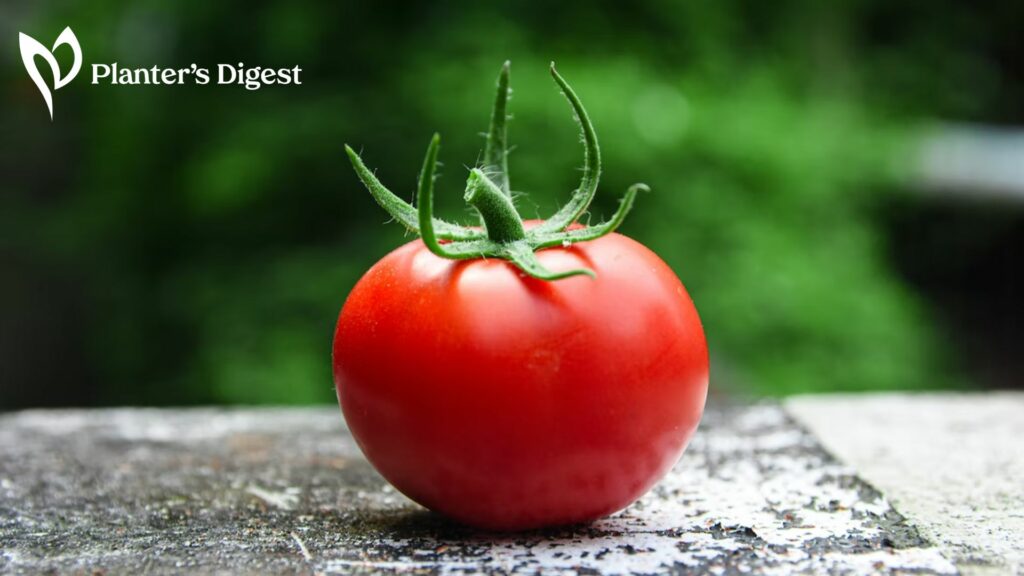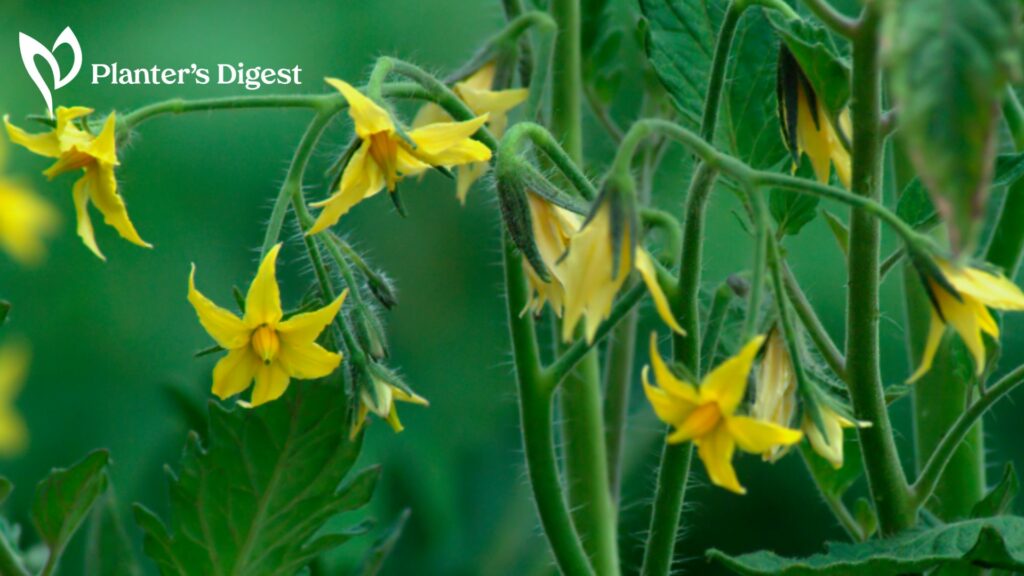
Mulch can do wonders for heavy feeders like tomatoes if you use it right. So if you’re a beginner, you’re in luck as we’ll break down all the whats, whys, whens, and hows of using mulch!
What is mulching tomatoes?

Mulching is the act of adding a layer of organic materials onto exposed soil to improve its quality and fertility, suppress weed growth, retain moisture, and regulate temperature.
There are an array of organic materials that can be used for mulching, from recycled newspaper to lawn clippings, depending on your personal preferences.
As a result, mulching is a cost-efficient and effective way of providing your plants with extra nutrients. It also acts as a protective barrier against pests and diseases that could harm your bare soil.
What are the benefits of mulching tomato plants?

Mulch is widely considered a gardener’s best friend and for good reason. It can provide a ton of benefits for your soil and plant, from helping retain moisture to preventing diseases.
Here’s the rundown on all the pros you’ll be getting by adding mulch to your soil.
1. Moisture Retention

Mulch promotes soil retention by slowing down the rate water evaporates. It acts as a physical barrier, protecting the soil from exposure to direct sunlight or wind, and keeping it moist for longer.
Hence, mulching is a tomato-saver, especially during hotter months when the soil dries out quickly but you don’t want to risk soil compassion and root rot.
So if you’ve been struggling with cracking tomatoes, mulching could definitely help out with ensuring that your plants are well-hydrated.
2. Insulation and Temperature Control

Mulch is a great source of insulation on both hot and cold days, acting as a protective cover against the elements. In a way, adding mulch to your soil is like giving it a big ‘ole hug.
During the colder months, mulch shields the soil from the harsh, cold air which prevents the soil from losing heat. Aside from that, mulch traps heat in the soil, keeping it warmer for longer.
Interestingly, heat is also generated as a byproduct of the breakdown of organic material. This adds more warmth to the soil, contributing to its insulation.

During warmer months, on the other hand, mulch also shields the soil from the scorching sunlight. Just like how we need a cap or an umbrella at the beach.
Did you know that the sun’s rays can heat up the soil? Hence, you’ll notice that the soil dries up quicker during the summertime even though you watered it, like, 10 minutes ago.
Adding mulch slows down how quickly the soil evaporates, which helps keep your plant hydrated for longer, especially during heat waves.
Keep in mind that the needed thickness of your mulch will depend on how cold or hot the weather is. You can achieve sufficient insulation with a layer that’s about 2 to 4 inches thick.
3. Weed Suppression

Weeds are a gardener’s worst nightmare since it’s really tricky to keep them out of your garden for good. You remove a couple and new ones pop back in after a few days.
Without properly controlling the weeds in your garden, you’ll simply be wasting fertilizers as these suckers quite literally take up all the resources in the soil that could have gone to your heavy-feeding tomato plant.

Luckily, adding mulch is an effective, budget-friendly, and low-maintenance solution to suppressing weed growth.
Mulch prevents weeds from getting sunlight, which they need to germinate and grow. Aside from that, a thick layer of mulch will make it difficult for weeds to penetrate, making it easier to pluck them out.
As a result, they’ll eventually die or remain dormant in the soil. For extra measure, you can add other weed control methods such as herbicides for permanent removal.
4. Disease Prevention

Who knew mulch could protect your tomato plants from diseases, too? Talk about an all-in-one agronomic tool!
Mulch prevents soil-borne pathogens from splashing onto the plant by creating a physical barrier between the soil and the tomato plant’s foliage.
As a result, there won’t be any splashing going on as long as you’ve got mulch on your soil.

Another way that mulch prevents diseases from spreading is by maintaining the moisture at a healthy and consistent level. This way, no fungi or bacteria will be able to grow.
Aside from that, mulch promotes the growth of healthy bacteria in the soil. As the organic matter decomposes, beneficial microorganisms suppress the growth of bacteria and fungi.
The cherry on top is that as the organic material breaks down, it releases a ton of nutrients and minerals into the soil. This boosts its quality and fertility for the next season.
5. Improved Soil Health

Given all these benefits, it’s no surprise that mulch can perform wonders at improving your soil’s overall health. This, in turn, will be evident in the health of your plant and the quality of its yields.
As it breaks down, mulch will boost the nutrient content of your soil. This is definitely what most gardeners look forward to as harvests tend to look exceptionally plump and juicy.
What’s great is that for as long as the mulch is decomposing, you won’t run out of free fertilizer.

Other than that, mulch prevents soil compaction by acting as a cushion when watering. As a result, the water can easily penetrate the soil, keeping it healthier for longer.
Otherwise, the soil will become denser over time and less porous. That’ll drastically affect the ability of water, nutrients, and oxygen to pass through.
Over time, mulch breaks down into crumbly and loose materials that help aerate the soil. This prevents it from compacting and losing its structure.
What are the best mulches for tomato plants?

Now you may be wondering, out of all the possible options in the market (or in your garden), which ones are the best for tomato plants?
Here are one of the best organic mulching materials that are ideal for your tomato plants:
1. Cardboard

Did you know that cardboard is a good mulching material? Now you know what to do with all those boxes from your Amazon packages!
One of the biggest benefits of using cardboard is that it’s a great source of carbon. As it decomposes, the carbon it releases into the soil helps improve the soil’s structure and ability to retain nutrients.

Secondly, cardboard is a great weed barrier since zero light passes through. In the same vein, cardboard also prevents your soil from drying out too quickly, especially during the summertime, as it blocks off the direct sunlight.
Having mentioned that, you can expect your soil to retain much more moisture than it normally would, especially if it’s pretty hot where you live.
If you’re an avid recycler, using cardboard is great as it prevents it from ending up at the landfill. Instead, it’s living the last leg of its life helping the environment.
2. Pine Needles

Pine needles are one of the best organic mulching materials because they provide a ton of benefits to your soil and plants. They’re also budget-friendly and can last you quite a while.
Hence, it’s unlikely that there isn’t a bag of pine mulch at your local gardening or landscape stores.
One of the most sought-after benefits that pine needles bring into your soil is their ability to boost microbial activity.
Without getting too deep into the science rabbit hole, good microbial activity transforms the nitrogen from the air into fertilizer. This way, it’s easier for your tomato plant to absorb.

Pine mulch also increases organism productivity. Our good ‘ole buddies, the earthworms, love soil that’s rich in organic matter such as pine needles.
Having these little critters around improves your soil’s health tremendously by creating tunnels that increase the amount of pore space in the soil. This creates space for oxygen, water, nutrients, and other resources to easily pass through.
Because of their shape, pine needles are also great at improving soil structure. As they break down, they add organic matter and nutrients to the soil such as iron, nitrogen, phosphorus, and calcium, among others.

Pine needles also act as physical protective barriers against poor weather, preventing soil particles from washing away easily. Without this, your soil stands no chance against the elements and can develop erosion over time.
However, be careful not to put too much mulch around the base of your tomato plant. That’ll trap moisture that could make your plant vulnerable to root rot.
Leave about a 6-inch gap between the stem of your tomato plant and the ring of mulch around it.
3. Compost

Every gardener knows the wonders a good mix of compost can bring to their soil and plants. In fact, we don’t know any gardener that doesn’t have any on hand, whether store-bought or homemade.
Compost is a type of manure that’s made from a variety of brown materials which are carbon-rich matter, and green materials which are high in nitrogen.
Each gardener’s compost recipe is different depending on who you ask. Though, the general rule of thumb is to mix 3 to 4 parts brown materials to 1 part green materials.
Here are a couple of effective brown and green materials that work well:
| Brown Materials | Green Materials |
| • Straw • Paper • Cardboard • Dry leaves • Wood prunings • Saw dust • Hay • Grass cuttings • Twigs • Pine needles and cones | • Organic manure (horse, cow, chicken, rabbit) • Vegetable or fruit peelings • Green leaves • Coffee grounds • Seaweed • Tea leaves or bags |
As you can see by these ingredients, using compost as mulch provides your plants with a great source of nutrients through a hearty release as it decomposes.
What’s great about compost is that it mixes into the soil quickly and well, which means that it doesn’t take long for the roots of your tomato plant to take in all the nutrients.
This is definitely what you should be looking for to grow healthy and large yields, especially since tomato plants are heavy feeders.

As it gradually breaks down, compost also keeps your good ‘old worm friends well-fed and contented. Remember this: happy worms = happy soil.
Over time, you’ll notice that your soil is easier to till, has better fertility, and is less susceptible to pests and diseases.
The only issue with using compost as your main mulch is that it doesn’t suppress weed growth. On the bright side, adding pine needles, cardboard, or shredded tree bark is a quick fix to this.
4. Grass Clippings

We’re certain that anyone who mows their lawn every couple of weeks ends up with bags’ worth of clippings that they have no clue what to do with.
Luckily, grass clippings can easily be repurposed in your garden by turning them into mulch.
If you’ve got fresh clippings, you can add a thin layer, about ¼ inch thick, onto your soil to help cool it down, preserve moisture, and increase nitrogen levels.

Be careful not to add too much clippings, though, as grass has the tendency to remain wet for a long while. This could increase your tomato plant’s susceptibility to mold, decay, or diseases.
A thin layer ensures that it doesn’t block water and air from getting through. It’ll also help speed up the drying process
Alternatively, you can use dry grass clippings as green materials in your compost as they’re a great source of nitrogen. Simply leave them in a pile and turn it every now and then until it’s dry.
5. Straw

For gardeners on a tight budget, straw is an affordable way to get all the benefits of mulch without putting a hole in your wallet.
Straw is widely available and can be bought in a variety of sizes depending on how much you need. A small bale costs about $7 and $10 while larger ones can range from $35 to $55.
One of the most popular types of straws used for mulching are rice straw, wheat straw, and golden straw. Just be wary of any seeds that could cause problems.
They’re great for preventing soil erosion because they break down easily so you’ll be able to notice improvements in the structure almost immediately.

Since they’re a type of brown material, they add organic matter into the soil as they decompose. That’ll ensure that the beneficial microorganisms in your soil are well-fed, creating a healthier environment for your tomato plant.
Straw is also known to help regulate temperatures during both hot and cold weather. It’s great at retaining moisture, which can lessen how frequently you water your plants.
It also shields the soil from the harsh sunlight that could dry it up. As a result, your tomato plant is less likely to get stressed out during weather changes.
Having mentioned that, straw also acts as a protective barrier against water splashing onto the foliage. This prevents soil-borne pathogens from attacking your tomato plant.
Not too shabby for a couple of bucks, right?
6. Shredded Dried Leaves

Shredded leaves are one of the best options for organic and natural mulches. They’re great at insulating the soil from harsh weather conditions.
During the day, it acts as a coating against the heat of the sun. That’ll shield your soil from drying out and warming up, which could stress out the roots of your plant.
In colder weather, the shredded leaves will keep the soil warm by trapping heat. To an extent, this could prolong the season until it’s just too cold.

As they slowly decompose, they release a ton of nutrients such as potassium, nitrogen, and phosphorus into the soil.
As the leaves break down, they’ll also add structure to your soil which will lessen the chances of compaction and erosion.
The organic matter will also improve the activity of beneficial microorganisms such as earthworms and bacteria. Keeping our little critter friends happy will result in better soil quality and fertility.

As a bonus, they’re completely free too! You can easily collect a few bags’ worth from your lawn in no time since you’ll need a thick 4 to 5-inch layer of mulch.
Just be sure to use leaves that have already started their decomposition process. So you can rake a pile and turn it every now and then before they’re ready to be used as mulch.
7. Shredded Tree Bark or Wood Chips

If you’re conscious about the look of your garden but don’t want to skip out on mulch, we think shredded tree bark is the way to go.
One of the most attractive types of mulch options on the market, they look straight out of a movie set without a hefty price tag.
Apart from their aesthetic appeal, shredded tree bark does a great job at retaining moisture and keeping your plants well-hydrated, especially in the summertime.
It also helps regulate temperatures, by acting as a thick, protective layer against the elements. Since your soil won’t be in direct contact with the wind, hot sunlight, or cold, the soil will be able to stay at a controlled temperature.
Thanks to this extra coating, you’re less likely to see weeds, too. As a result, you can lay back on the herbicides and weeding.

Despite all of this, there’s a chance that shredded bark can gradually absorb the nitrogen from the soil over time. This can drastically affect the quality and fertility of your soil, especially if it isn’t in the best shape, to begin with.
To address this, you can simply add a nitrogen-rich fertilizer to the soil to replenish it.
When is the best time to mulch tomato plants?

The best time to mulch is in mid-to-late spring when the soil has warmed up and your tomato seedling has established roots and foliage.
Alternatively, you can also mulch in early winter to prevent your soil from completely freezing up. That’ll make it easier for it to thaw as temperatures rise.
Hence, the most effective times to mulch are either early in the wintertime or mid-to-late spring.
Mulching any time in between could prevent the soil from warming up since temperatures could still be too cold. This could make the soil difficult to work with and delay the start of your season.
About 2 to 4 weeks after transplanting is enough time for your tomato seedling to grow roots that are strong enough to penetrate a thin layer of mulch.
How much mulch should I give my tomato plants?

How much mulch is too mu(l)ch? Get it? Mulch… Much… See? Anyhoo…
A good layer of mulch should be around 2 to 3 inches thick. As it decomposes, gradually add more to keep its height. Ensure that it’s spread evenly around your plant with about a 2 to 3-inch gap from the base or stem.
It’s important to be wary of putting too much mulch as it could prevent oxygen from passing through. Over time, this could cause root suffocation and your tomato plant will die.
Excessive mulch will create the perfect environment for fungi and bacteria to thrive because it’s moist and humid. This will increase the chances of your tomato plant catching a disease, or worse, wreak havoc on your entire garden.
Too much mulch will also cause nutrient imbalances in your soil. For example, excessive amounts of nitrogen can cause delayed flowering and reduced fruit sets.
As they say, too much of a good thing can become bad, so don’t overdo it.
FAQs
Shredded newspaper is a good material for mulch since it’s biodegradable, retains moisture well, and suppresses weed growth.
However, newspapers don’t have much nutritional value that your tomato plant can benefit from. It also doesn’t break down quickly enough to release a substantial amount of nutrients into the soil.
Other than that, newspapers may have been printed with toxic ink, like petroleum-based inks, or other harmful chemicals that could leach into the soil. If you want to use newspaper as mulch, ensure that it is printed with eco-friendly ink such as soy-based ink.
Peat moss is great to add to your soil as it’s lightweight and an effective soil amendment. It’s also great for retaining moisture, especially in warmer weather.
Though, overall, peat moss isn’t a good mulch material because it doesn’t have much nutritional value that could improve your tomato plant’s health.
It’s also highly acidic, which is too much for your tomato plant. They prefer a soil pH level of around 6.2 to 6.8, while peat moss has a pH of about 3.- to 4.5.
You can reuse old mulch as long as it doesn’t have any signs of mold, fungi, or disease. To repurpose, simply toss it around to give it a good mix and add fresh mulch on top.
There are three types of mulch – organic, synthetic, and inorganic.
• Organic mulch are natural materials that break down over time.
• Synthetic mulch is usually made from plastic or recycled rubber such as black plastic film.
• Inorganic mulch comes from stone or mineral-based materials such as rock and gravel.




